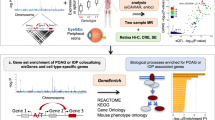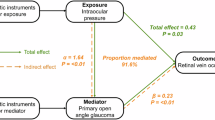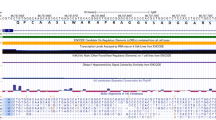Abstract
Primary open-angle glaucoma (POAG) is the most common chronic optic neuropathy worldwide. Epidemiological studies show a robust positive relation between intraocular pressure (IOP) and POAG and modest positive association between IOP and blood pressure (BP), while the relation between BP and POAG is controversial. The International Glaucoma Genetics Consortium (n=27 558), the International Consortium on Blood Pressure (n=69 395), and the National Eye Institute Glaucoma Human Genetics Collaboration Heritable Overall Operational Database (n=37 333), represent genome-wide data sets for IOP, BP traits and POAG, respectively. We formed genome-wide significant variant panels for IOP and diastolic BP and found a strong relation with POAG (odds ratio and 95% confidence interval: 1.18 (1.14–1.21), P=1.8 × 10−27) for the former trait but no association for the latter (P=0.93). Next, we used linkage disequilibrium (LD) score regression, to provide genome-wide estimates of correlation between traits without the need for additional phenotyping. We also compared our genome-wide estimate of heritability between IOP and BP to an estimate based solely on direct measures of these traits in the Erasmus Rucphen Family (ERF; n=2519) study using Sequential Oligogenic Linkage Analysis Routines (SOLAR). LD score regression revealed high genetic correlation between IOP and POAG (48.5%, P=2.1 × 10−5); however, genetic correlation between IOP and diastolic BP (P=0.86) and between diastolic BP and POAG (P=0.42) were negligible. Using SOLAR in the ERF study, we confirmed the minimal heritability between IOP and diastolic BP (P=0.63). Overall, IOP shares genetic basis with POAG, whereas BP has limited shared genetic correlation with IOP or POAG.
Similar content being viewed by others
Log in or create a free account to read this content
Gain free access to this article, as well as selected content from this journal and more on nature.com
or
References
Tham YC, Li X, Wong TY, Quigley HA, Aung T, Cheng CY : Global prevalence of glaucoma and projections of glaucoma burden through 2040: a systematic review and meta-analysis. Ophthalmology 2014; 121: 2081–2090.
Boland MV, Ervin AM, Friedman DS et al: Comparative effectiveness of treatments for open-angle glaucoma: a systematic review for the U.S. Preventive Services Task Force. Ann Intern Med 2013; 158: 271–279.
Sommer A, Tielsch JM, Katz J et al: Relationship between intraocular pressure and primary open angle glaucoma among white and black Americans. The Baltimore Eye Survey. Arch Ophthalmol 1991; 109: 1090–1095.
Zhao D, Cho J, Kim MH, Guallar E : The association of blood pressure and primary open-angle glaucoma: a meta-analysis. Am J Ophthalmol 2014; 158: 615–627.
Leske MC, Wu SY, Hennis A, Honkanen R, Nemesure B : Risk factors for incident open-angle glaucoma: the Barbados Eye Studies. Ophthalmology 2008; 115: 85–93.
Topouzis F, Wilson MR, Harris et al: Association of open-angle glaucoma with perfusion pressure status in the Thessaloniki Eye Study. Am J Ophthalmol 2013; 155: 843–851.
Tielsch JM, Katz J, Sommer A, Quigley HA, Javitt JC : Hypertension, perfusion pressure, and primary open-angle glaucoma. A population-based assessment. Arch Ophthalmol 1995; 113: 216–221.
Rossetti L, Sacchi M, Karabatsas CH et al: Comparison of the effects of bimatoprost and a fixed combination of latanoprost and timolol on 24-hour blood and ocular perfusion pressures: the results of a randomized trial. BMC Ophthalmol 2015; 15: 7.
Januleviciene I, Siaudvytyte L, Diliene V et al: Comparison of intraocular pressure, blood pressure, ocular perfusion pressure and blood flow fluctuations during dorzolamide versus timolol add-on therapy in prostaglandin analogue treated glaucoma subjects. Pharmaceuticals (Basel) 2012; 5: 325–338.
Leske MC, Heijl A, Hyman L, Bengtsson B, Dong L, Yang Z : Predictors of long-term progression in the early manifest glaucoma trial. Ophthalmology 2007; 114: 1965–1972.
De Moraes CG, Liebmann JM, Greenfield DS, Gardiner SK, Ritch R, Krupin T : Risk factors for visual field progression in the low-pressure glaucoma treatment study. Am J Ophthalmol 2012; 154: 702–711.
Hysi PG, Cheng CY, Springelkamp H et al: Genome-wide analysis of multi-ancestry cohorts identifies new loci influencing intraocular pressure and susceptibility to glaucoma. Nat Genet 2014; 46: 1126–1130.
Ehret GB, Munroe PB, Rice KM et al: Genetic variants in novel pathways influence blood pressure and cardiovascular disease risk. Nature 2011; 478: 103–109.
Burdon KP, Macgregor S, Hewitt AW et al: Genome-wide association study identifies susceptibility loci for open angle glaucoma at TMCO1 and CDKN2B-AS1. Nat Genet 2011; 43: 574–578.
Thorleifsson G, Walters GB, Hewitt AW et al: Common variants near CAV1 and CAV2 are associated with primary open-angle glaucoma. Nat Genet 2010; 42: 906–909.
Tham YC, Liao J, Vithana EN et al: Aggregate effects of intraocular pressure and cup-to-disc ratio genetic variants on glaucoma in a multiethnic asian population. Ophthalmology 2015; 122: 1149–1157.
Bulik-Sullivan B, Finucane HK, Anttila V et al: An atlas of genetic correlations across human diseases and traits. Nat Genet 2015; 47: 1236–1241.
Finucane HK, Bulik-Sullivan B, Gusev et al: Partitioning heritability by functional annotation using genome-wide association summary statistics. Nat Genet 2015; 47: 1228–1235.
Bulik-Sullivan BK, Loh PR, Finucane HK et al: LD Score regression distinguishes confounding from polygenicity in genome-wide association studies. Nat Genet 2015; 47: 291–295.
Bailey JN, Loomis SJ, Kang JH et al: Genome-wide association analysis identifies TXNRD2, ATXN2 and FOXC1 as susceptibility loci for primary open-angle glaucoma. Nat Genet 2016; 48: 189–194.
1000 Genomes Project Consortium 1000 Genomes Project Consortium, Abecasis GR 1000 Genomes Project Consortium, Auton et al: An integrated map of genetic variation from 1,092 human genomes. Nature 2012; 491: 56–65.
Devlin B, Roder K : Genomic control for association studies. Biometrics 1999; 55: 997–1004.
Henneman P, Aulchenko YS, Frents RR et al: Prevalence and heritability of th emetabolic syndrome and its individual components in a Dutch osilate: the Erasmus Rucphen Family Study. J Med Genet 2008; 45: 572–577.
Almasy L, Blangero J : Mulitpoint qunatitative-trait linkage analysis in general pedigrees. Am J Hum Genet 1998; 62: 1198–1211.
Almasy L, Dyer TD, Blangero J : Bivariate quantitative trait linkage analysis: pleiotropy versus co-incident linkages. Genet Epidemiol 1997; 14: 953–958.
Bonomi L, MarchiniG, Marraffa M et al: Vascular risk factors for primary open angle glaucoma: the Egna-Neumarkt Study. Ophthalmology 2000; 107: 1287–1293.
Aschard H : A perspective on interaction effects in genetic association studies. Genet Epidemiol 2016; 40: 678–688.
Dielemens I, Vingerling JR, Wolfs RC, Hofman A, Grobbee DE, deJong PT : The prevalence of primary open-angle glaucoma in a population-based study the Netherlands. The Rotterdam Study. Ophthalmology 1994; 10: 1851–1855.
Tryggvason G, Jonasson F, Cotch MF et al: Hearing in older adults with exfoliation syndrome/exfoliation glaucoma or primary open-angle glaucoma. Acta Ophthalmol 2016; 94: 140–146.
van Rijn MJ, Schut AF, Aulchenko YS et al: Heritability of blood pressure traits and the genetic contribution to blood pressure variance explained by four blood-pressure-related genes. J Hypertens 2007; 25: 565–570.
Lu Y, Vitart V, Burdon KP et al: Genome-wide association analyses identify multiple loci associated with central corneal thickness and keratoconus. Nat Genet 2013; 45: 155–163.
Barrett JC, Clayton DG, Concannon P et al: Genome-wide association study and meta-analysis find that over 40 loci affect risk of type 1 diabetes. Nat Genet 2009; 41: 703–707.
de Boer YS, van Gerven NM, Zwiers et al: Genome-wide association study identifies variants associated with autoimmune hepatitis type 1. Gastroenterology 2014; 147: 443–452.
Wiggs JL, Yaspan BL, Hauser MA et al: Common variants at 9p21 and 8q22 are associated with increased susceptibility to optic nerve degenerationin glaucoma. PLoS Genet 2012; 8: e1002654.
Chen Y, Hughes G, Chen X et al: Genetic variants associated with different risks for high tension glaucoma and normal tension glaucoma in a Chinese population. Invest Ophthalmol Vis Sci 2015; 56: 2595–2600.
Khawaja A, Crabb DP, Jansonius NM : Time to abandon over-simplified surrogates of ocular perfusion pressure in glaucoma research. Acta Ophthalmologica 2015; 93: e85.
Ramdas WD, Wolfs RC, Hofman A, deJOng PT, Vingerling JR, Jansonius WM : Ocular perfusion pressure and the incidence of glaucoma: real effect or artifact. The Rotterdam Study. Invest Ophthalmol Vis Sci 2011; 52: 6875–6881.
Tekiara JM : Genetic factors in open-angle (simple and capsular) glaucoma. A population-based twin study. Acta Ophthalmol (Copenh) 1987; 65: 715–720.
Cuellar-Partida G, Craig JE, Burdon KP et al: Assessment of polygenic effects links primary open-angle glaucoma and age-related macular degeneration. Sci Rep 2016; 6: 26885.
Sanfilippo PG, Hewitt AN, Hammond CJ, Mackey DA : The heritability of ocular traits. Surv Ophthalmol 2010; 44: 561–583.
Sit AJ : Intraocular pressure variations: causes and clinical significance. Can J Ophthalmol 2014; 49: 484–488.
Qureshi IA, Xi XR, Lu HJ, Wu XD, Huang YB, Shiarkar E : Effect of seasons upon intraocular pressure in healthy population of China. Korean J Ophthalmol 1996; 10: 29–33.
Doughty MJ, Zaman ML : Human corneal thickness and its impact on intraocular pressure measures: a review and meta-analysis approach. Surv Ophthalmol 2000; 44: 367–408.
Lamparter J, Hoffmann EM : Measuring intraocular pressure by different methods. Ophthalmologe 2009; 106: 676–682.
Dimasi DP, Burdon KP, Craig JE : The genetics of central corneal thickness. Br J Ophthalmol 2010; 94: 971–976.
Park SJ, Ang GS, Nicholas S, Wells AP : The effect of thin, thick and normal corneas on Goldmann intraocular pressure measurements and correction formulae in individual eyes. Ophthalmology 2012; 119: 443–449.
Liu C, Kraja A, Smith JA et al: Meta-analysis identifies common and rare variants influencing blood pressure and overlapping with metabolic trait loci. Nat Genet 2016; 48: 1162–1170.
Acknowledgements
NIH EY015473 supports this work. The numerous other grants that support this work are listed as Supplementary material. Web Resources: The LD score regression analyses were performed using the implementation of the LD score method provided at: https://github.com/bulik/ldsc.
Author information
Authors and Affiliations
Consortia
Corresponding author
Ethics declarations
Competing interests
The authors declare no conflict of interest.
Additional information
Supplementary Information accompanies this paper on European Journal of Human Genetics website
Supplementary information
Rights and permissions
About this article
Cite this article
Aschard, H., Kang, J., Iglesias, A. et al. Genetic correlations between intraocular pressure, blood pressure and primary open-angle glaucoma: a multi-cohort analysis. Eur J Hum Genet 25, 1261–1267 (2017). https://doi.org/10.1038/ejhg.2017.136
Received:
Revised:
Accepted:
Published:
Issue date:
DOI: https://doi.org/10.1038/ejhg.2017.136
This article is cited by
-
Optimizing the sequential approach of combined phacoemulsification and gonioscopy-assisted transluminal trabeculotomy (GATT) in primary open-angle glaucoma
BMC Ophthalmology (2025)
-
GWAS-by-subtraction reveals an IOP-independent component of primary open angle glaucoma
Nature Communications (2024)
-
Whole-exome sequencing study identifies rare variants and genes associated with intraocular pressure and glaucoma
Nature Communications (2022)
-
Objectives, design and main findings until 2020 from the Rotterdam Study
European Journal of Epidemiology (2020)



